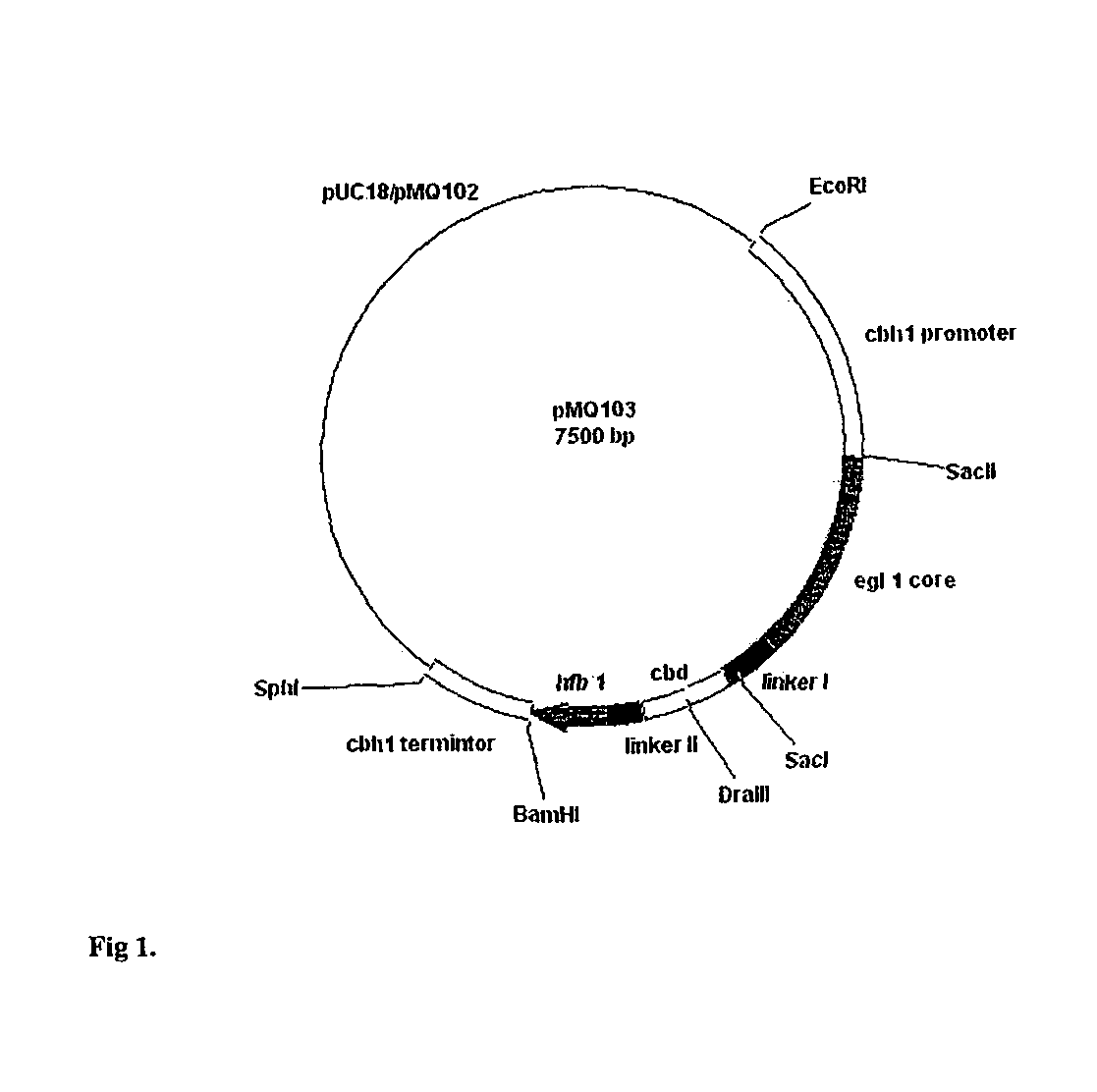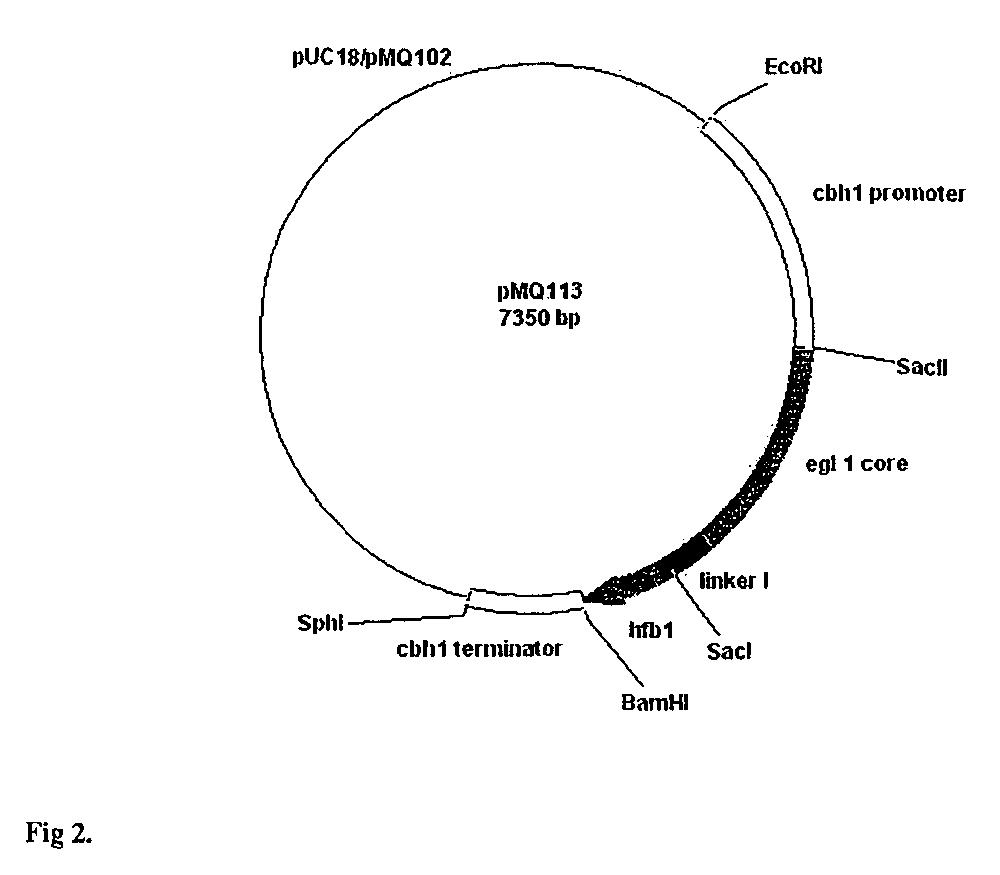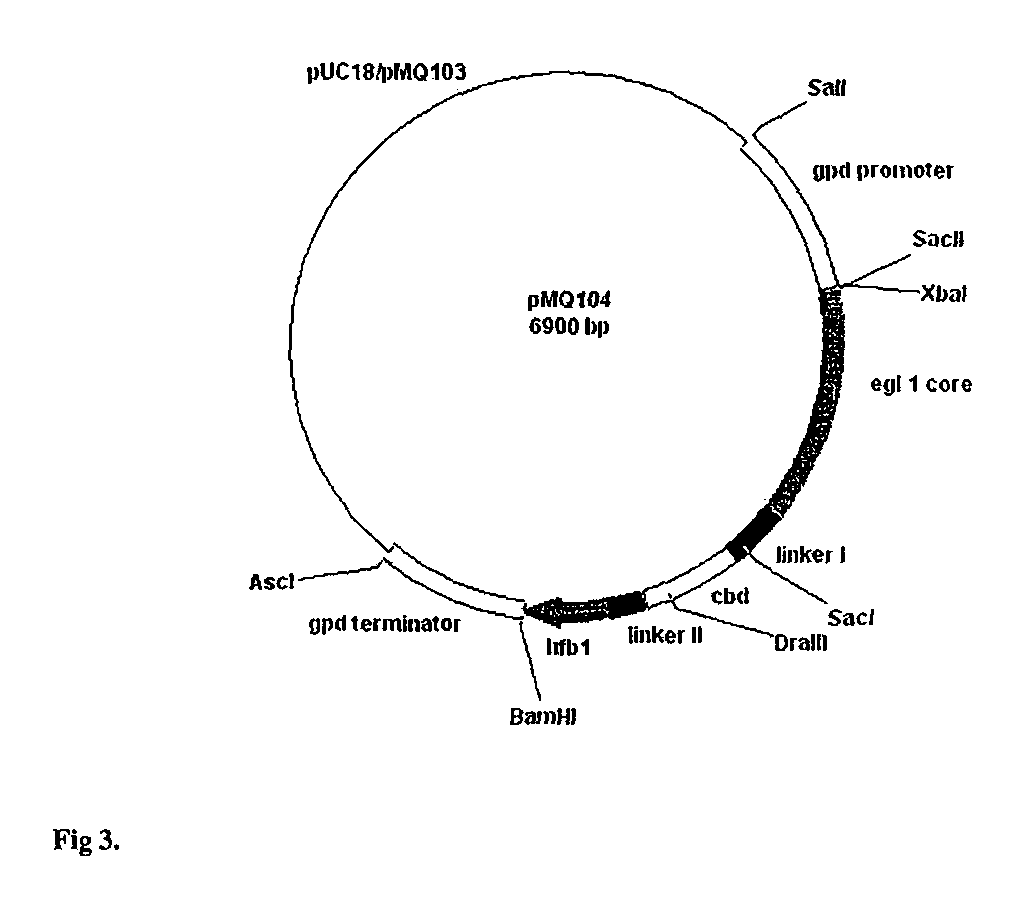Process for partitioning of proteins
a protein and process technology, applied in the field of protein partitioning, can solve the problems of reducing the performance of conventional solid-liquid separation methods, unable to provide a physical picture of phase behaviour of the designed model, and hardly possible prediction
- Summary
- Abstract
- Description
- Claims
- Application Information
AI Technical Summary
Benefits of technology
Problems solved by technology
Method used
Image
Examples
example 1
Construction of Vectors for Expression of EGI and EGIcore HFBI Fusion Proteins under the cbh1 and gpd1 Promoters of Trichoderma and gpdA Promoter of Aspergillus
[0071]For construction of an EGI-HFBI fusion protein, hfb1 (SEQ ID 1) coding region (from Ser-23 to the STOP codon) and a peptide linker (Val Pro Arg Gly Ser Ser Ser Gly Thr Ala Pro Gly Gly)(SEQ ID NO: 38) preceding it was amplified with PCR using pTNS9 as a template and as a 5′ primer TCG GG CACTACGTG C CAG TAT AGC AAC GAC TAC TAC TCG CAA TGC CTT GTT CCG CGT GGC TCT AGT TCT GGA ACC GCA (SEQ ID 2) and as a 3′ primer TCG TAC GGATCC TCA AGC ACC GAC GGC GOT (SEQ ID 3). pTNS9 has been decribed in detail in Example 19. The sequence in bold in the 5′ primer encodes 16 C-terminal residues of EGI. The sequence in italics is a thrombin cleavage site and the underlined CACTACGTG is a DraIII site. The underlined GGATCC in the 3′ primer is a BamHI site. The 280 bp PCR fragment was purified from agarose gel and ligated to pGEM-T T / A vect...
example 2
Construction of Vectors for Over-Production of HFBI on Cellulase-Inducing and -Repressing Media
[0075]For over-expression of HFBI under cbh1 promoter the protein coding region of hfb1 was amplified with PCR using as a template pEA10 (Nakari-Setälä et al, 1996). pEA10 carries a 5.8 kb genomic SalI fragment containing hfb1 coding and flanking sequences. GTC AA C CGC GG A CTG CGC ATC ATG AAG TTC TTC GCC ATC (SEQ D 13) was used as a 5′ primer in the PCR and as a 3′ primer SEQ ID 3. The sequence in bold in the 5′ primer is 21 bp of cbh1 promoter adjacent to translational start site of the corresponding gene and the underlined CCGCGG is a KspI site. The obtained fragment of 430 bp was digested with KspI and BamHI and ligated to pMQ103 digested with KspI and BamHI. The resulting plasmid pMQ121 (FIG. 7) carries the coding sequence of hfb1 operably linked to cbh1 transcriptional control sequences. pEA10 plasmid is used for over-production of HFBI in cellulase-repressing conditions.
example 3
Transformation of Trichoderma and Purification of the EGI-HFBI and EGIcore-HFBI Producing and HFBI Over-Producing Clones
[0076]Trichoderma reesei strains QM9414 (VTT-D-74075) and Rut-C30 (VTT-D-86271) were co-transformed essentially as described (Penttilä et al., 1987) using 3–13 μg of the plasmids pMQ103, pMQ113, pMQ104, pMQ114, pMQ105, pMQ115, pMQ121 and pEA10 and as the selection plasmids 1–3 μg pToC202, p3SR2 or pARO21. pToC202 (pUC19 backbone) and p3SR2 (pBR322 backbone) plasmids carry 2.7 kb XbaI and 5 kb EcoRI-SalI genomic fragments of A. nidulans, respectively, containing the amdS gene (Hynes et al, 1983; Tilburn et al., 1983). pARO21 is essentially the same as pRLMex30 (Mach et al. 1994) and carries the E. coli hph gene operably linked to 730 bp of pki1 promoter and 1 kb of cbh2 terminator sequences of T. reesei. The Amd+ and Hyg+ transformants obtained were streaked three times onto plates containing acetamide and hygromycin, respectively (Penttilä et al., 1987). Thereafter...
PUM
| Property | Measurement | Unit |
|---|---|---|
| concentration | aaaaa | aaaaa |
| temperature | aaaaa | aaaaa |
| volume | aaaaa | aaaaa |
Abstract
Description
Claims
Application Information
 Login to View More
Login to View More - R&D
- Intellectual Property
- Life Sciences
- Materials
- Tech Scout
- Unparalleled Data Quality
- Higher Quality Content
- 60% Fewer Hallucinations
Browse by: Latest US Patents, China's latest patents, Technical Efficacy Thesaurus, Application Domain, Technology Topic, Popular Technical Reports.
© 2025 PatSnap. All rights reserved.Legal|Privacy policy|Modern Slavery Act Transparency Statement|Sitemap|About US| Contact US: help@patsnap.com



